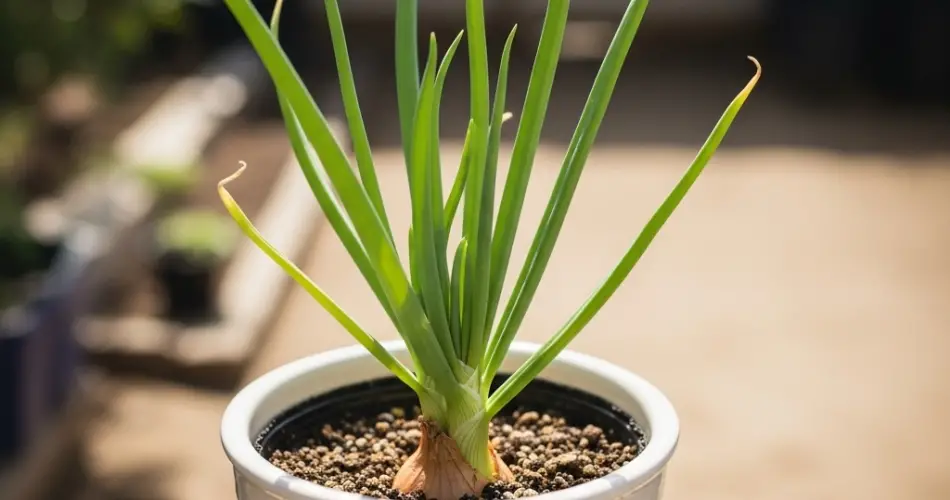Onions are a staple in kitchens around the world—and fortunately, they’re just as easy to grow at home as they are essential in cooking. If you don’t have a backyard garden, don’t worry: onions grow remarkably well in containers. Whether you’re using a balcony, patio, or even a sunny kitchen corner, you can cultivate a fresh supply of onions with minimal space and effort.
From green onions to full-sized bulbs, growing onions in pots is a convenient and satisfying way to add fresh flavor to your meals straight from your own home.
Why Grow Onions in Pots?
Container gardening offers flexibility and control over growing conditions. Onions are an ideal candidate because:
-
They don’t need deep soil.
-
You can grow them in small batches for a continuous harvest.
-
Containers make it easier to manage pests and weeds.
-
They’re adaptable to indoor or outdoor spaces.
Growing onions in pots also allows you to produce both green tops (for garnishing) and mature bulbs depending on your needs and how long you let them grow.
Best Onion Types for Containers
There are several types of onions you can grow, each with its own growth timeline and flavor profile:
-
Green onions (scallions): Fast-growing and ideal for small pots. You can harvest in 3–4 weeks.
-
Bulb onions: Take longer but can be grown in larger containers. Varieties like ‘White Lisbon,’ ‘Red Burgundy,’ or ‘Yellow Granex’ are popular choices.
-
Shallots and multiplier onions: Smaller, clustered bulbs that do well in containers and produce multiple offshoots from one planting.
-
Bunching onions: Perennial in warm climates, offering repeat harvests over time.
Choose a type based on how much space you have and how quickly you want results. For faster harvests, green onions or shallots are the best choices.
Choosing the Right Container
The container you choose should be based on the type of onion you plan to grow. For green onions, a pot that’s 6–8 inches deep will suffice. For bulb onions, choose a container at least 10–12 inches deep to allow for proper root development.
Wide, shallow planters or plastic tubs work well for planting multiple onions at once. Just make sure your container has good drainage holes to prevent water from collecting and causing rot.
You can even repurpose items like crates, storage bins, or buckets as long as they’re deep enough and have holes drilled in the bottom.
Soil and Fertilizer
Onions prefer loose, fertile, and well-draining soil. Use a quality potting mix enriched with compost or aged manure. Avoid using heavy garden soil in containers as it may compact and reduce bulb formation.
Onions are moderate feeders. At planting, mix in a balanced organic fertilizer or compost. As they grow, you can feed them every 2–3 weeks with a nitrogen-rich liquid fertilizer to encourage leaf growth, which helps with bulb development later.
Planting Onions in Pots
You can start onions from:
-
Seeds: Cheapest option but takes the longest—up to 5 months for bulbs.
-
Sets: Small pre-grown bulbs that grow quickly and are beginner-friendly.
-
Transplants: Seedlings that offer a head start but may require gentle handling.
Here’s how to plant:
-
Fill your container with potting mix, leaving 1–2 inches from the rim.
-
Make holes 1 inch deep and space each onion 3–4 inches apart for green onions, or 4–6 inches for bulb onions.
-
Plant sets or seedlings root-side down, pointy end up.
-
Cover gently with soil and water thoroughly.
For green onions, you can plant them closer together and harvest more frequently.
Light and Watering
Onions love sunlight. Give them at least 6–8 hours of full sun daily. Place your container on a sunny balcony, windowsill, or patio. If growing indoors, position the pot near a bright window or use grow lights for better results.
Keep the soil evenly moist but not soggy. Water when the top inch of soil feels dry. Onions have shallow roots, so consistent moisture is key—especially during bulb formation.
Avoid overhead watering, which can lead to fungal problems. Instead, water at the base of the plant.
Harvesting Your Onions
Green onions can be harvested as soon as the tops are 6–8 inches tall. Use scissors to snip off the green stalks as needed. They will continue to grow for multiple harvests if the base remains intact.
Bulb onions are ready to harvest when the tops begin to yellow and fall over. This usually occurs 90–120 days after planting. To harvest:
-
Gently loosen the soil and pull up the bulbs.
-
Cure the bulbs by laying them in a dry, well-ventilated area out of direct sun for 1–2 weeks.
-
Once the skins are dry and papery, trim the roots and stems, and store in a cool, dark place.
Final Tips for Success
-
Rotate your container occasionally to ensure even sun exposure.
-
Remove weeds or competing seedlings from the pot to avoid crowding.
-
Check for pests like onion thrips or aphids and treat early with neem oil or insecticidal soap.
-
For a continual supply, plant a new batch of green onions every few weeks.
With a bit of space and care, you can grow fresh, flavorful onions right from your balcony or kitchen. From quick-growing green onions to fully formed bulbs, container-grown onions are a rewarding crop that enhances your cooking and brings your home garden to life.



